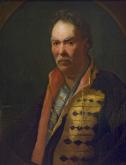Portrait of a Field Hetman
1720s (1726 or 1727 (?))
- oil on canvas. 76 x 60 (oval in rectangle)
- Ж-4909
Received in 1923 from the Academy of Arts- Provenance: Winter Palace (until 1765 (?))
- Period 18th century
- CategoryPortrait
- Share
In the nineteenth century, this portrait was commonly believed to depict a hetman — Ivan Mazeppa, Pavlo Polubotok, Ivan Skoropadsky or Daniil Apostol. In 1958, A. N. Savinov suggested that it depicted the Lithuanian hetman Count Casimir Jan Sapega, a fieldmarshal of the Russian army who lived in St Petersburg in the mid-1720s. It is very hard to say exactly who is portrayed in this work. The rank of field hetman inscribed on the portrait was more typical of Poland and Lithuania, where the positions of crown hetman (commander-in-chief) and field hetman (deputy commander-in-chief) existed in the early eighteenth century. In a conference at the Hermitage Museum in 1984, Sergei Androsov suggested that the work was actually a self-portrait. Russian Museum: From Icons to the Modern Times. Palace Editions, St Petersburg, 2015. P. 76.
The portrait was included in the 1773 inventory of academic paintings as «a portrait of a field hetman, uncompleted, taken from the palace with no frame.» The portrait of Ivan Mazepa was exhibited within an exhibition of 1879 with a note in the catalogue that read «painted by Ivan Nikitin.» After that Nikitin’s authorship has never been questioned.

